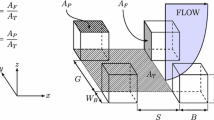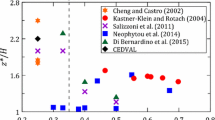Abstract
Estimates of aerodynamic parameters, in particular roughness length z 0 and displacement height d, are important for the analysis of the roughness of an urban surface, which affects processes that occur within the urban boundary layer such as pollutant dispersion and urban ventilation. Findings regarding the aerodynamic effects of various configurations of urban arrays were compiled from various studies. Several experimental, numerical and semi-empirical studies to estimate z 0 and d were reviewed and compared with each other. The results can be summarized as follows: (1) the influence of the frontal area index (λ f ) on z 0 is significant and their relationship has been confirmed by both experimental and numerical data; (2) compared to one-parameter and two-parameter fitting methods, the three-parameter fitting method is the least accurate; (3) the physical meaning of d remains vague because its definition as the height where surface drag acts may not be accurate for sharp-edged roughness blocks and (4) the peak values of z 0 for uniform and heterogeneous block heights indicate presence of skimming or wake-interference flow effects, which may influence surface roughness. Finally, the semi-empirical models were found to be limited to cases derived from available experimental data, which normally involve uniform arrays of cubes.






Similar content being viewed by others
References
Abd Razak A, Hagishima A, Ikegaya N, Tanimoto J (2012) Analysis of airflow over building arrays for assessment of urban wind environment. Build Environ 59:56–65. doi:10.1016/j.buildenv.2012.08.007
Akins RE, Peterka JA, Cermak JE (1977) Mean force and moment coefficients for buildings in turbulent boundary layers. J Wind Eng Ind Aerodyn 2:195–209
Bao JW, Michelson SA, Wilczak JM (2002) Sensitivity of numerical simulations of parameterizations of roughness for surface heat fluxes at high winds over the sea. AMS Mon Weather Rev 130
Boppana VBI, Xie ZT, Castro IP (2010) Large-eddy simulation of dispersion from surface sources in arrays of obstacles. Boundary-Layer Meteorol 135:433–454. doi:10.1007/s10546-010-9489-9
Bottema M (1995) Parameterization of aerodynamic roughness parameters in relation with air pollutant removal efficiency of streets. Environ Trans Ecol 6:2–9
Bottema M (1996) Roughness parameters over regular rough surfaces: experimental requirements and model validation. J Wind Eng Ind Aerodyn 64:249–265
Cao M, Lin Z (2014) Impact of urban surface roughness length parameterization scheme on urban atmospheric environment simulation. J App Math Article ID: 267683
Cheng H, Castro IP (2002) Near wall flow over urban-like roughness. Boundary-Layer Meteorol 104:229–259
Cheng H, Hayden P, Robins AG, Castro IP (2007) Flow over cube arrays of different packing densities. J Wind Eng Ind Aerodyn 95:715–740. doi:10.1016/j.jweia.2007.01.004
Claus J, Coceal O, Thomas TG, Branford S, Belcher SE, Castro IP (2012) Wind-direction effects on urban-type flows. Boundary-Layer Meteorol 142:265–287. doi:10.1007/s10546-011-9667-4
Clauser FH (1956) The turbulent boundary layer. Adv Appl Mech 4:1–51
Coceal O, Thomas TG, Castro IP, Belcher SE (2006) Mean flow and turbulence statistics over groups of urban-like cubical obstacles. Boundary-Layer Meteorol 121:491–519. doi:10.1007/s10546-006-9076-2
Coceal O, Goulart EV, Branford S, Thomas TG, Belcher SE (2014) Flow structure and near-field dispersion in arrays of building-like obstacles. J Wind Eng Ind Aerodyn 125:52–68
Coles DE (1956) The law of the wake in the turbulent boundary layers. J Fluid Mech 1:191–226
Counihan J (1971) Wind tunnel determination of the roughness length as a function of the fetch and the roughness density of three-dimensional roughness elements. Atmos Environ 5:637–642
Di Sabatino S, Solazzo E, Paradisi P, Britter R (2008) A simple model for spatially-averaged wind profiles within and above an urban canopy. Boundary-Layer Meteorol 127:131–151. doi:10.1007/s10546-007-9250-1
ESDU (1980) Mean fluid forces and moments on rectangular prisms: surface-mounted structures in turbulent shear flow. Engineering Sciences Data Item Number 80003
Farell C, Iyengar AKS (1999) Experiments on the wind tunnel simulation of atmospheric boundary layers. J Wind Eng Ind Aerodyn 79:11–35. doi:10.1016/S0167-6105(98)00117-2
Garrat JR (1992) The atmospheric boundary layer. Cambridge University Press, Melbourne
Hagishima A, Tanimoto J, Nagayama K (2009) Aerodynamic parameters of regular arrays of rectangular blocks with various geometries. Boundary-Layer Meteorol 132:315–337. doi:10.1007/s10546-009-9403-5
Hama FR (1954) Boundary layer characteristics for smooth and rough surfaces. Trans Soc Nav Archit Mar Eng 62:333–358
Huq P, Franzese P (2012) Measurements of turbulence and dispersion in three idealized urban canopies with different aspect ratios and comparisons with a Gaussian plume model. Boundary-Layer Meteorol 147:103–121. doi:10.1007/s10546-012-9780-z
Iyengar AKS, Farell C (2001) Experimental issues in atmospheric boundary layer simulations: roughness length and integral length scale determination. J Wind Eng Ind Aerodyn 89:1059–1080
Jackson PS (1981) On the displacement height in the logarithmic velocity profile. J Fluid Mech 111:15–25
Jiang D, Jiang W, Liu H, Sun J (2008) Systematic influence of different building spacing, height, and layout on mean wind and turbulent characteristics within and over building arrays. Wind Struct 11:275–289
Jiang X, Lai C (2009) Numerical techniques for direct and large-eddy simulations. CRC Press, Boca Raton
Kanda M, Moriwaki RYO, Kasamatsu F (2004) Large-eddy simulation of turbulent organized structures within and above explicitly resolved cube arrays. Boundary-Layer Meteorol 112:343–368
Kanda M, Moriizumi T (2009) Momentum and heat transfer over urban-like surfaces. Boundary-Layer Meteorol 131:385–401
Kanda M, Inagaki A, Miyamoto T, Gryschka M, Raasch S (2013) A new aerodynamic parameterization for real urban surfaces. Boundary-Layer Meteorol 148:357–377. doi:10.1007/s10546-013-9818-x
Kutzbach J (1961) Investigations of the modification of wind profiles by artificially controlled surface roughness. Studies of the three dimensional structure of the planetary boundary layer. Annu Rep 1961, Dept. of Meteorology, University of Wisconsin, Madison, 71–113
Leonardi S, Orlandi P, Smalley RJ, Djenidi L, Antonia RA (2003) Direct numerical simulations of turbulent channel flow with transverse square bars on one wall. J Fluid Mech 491:229–238. doi:10.1017/S0022112003005500
Leonardi S, Castro IP (2010) Channel flow over large cube roughness: a direct numerical simulation study. J Fluid Mech 651:519–539. doi:10.1017/S002211200999423X
Lettau H (1969) Note on aerodynamic roughness-parameter estimation on the basis of roughness-element description. J Appl Meteorol 8:828–832
Macdonald RW, Griffiths RF, Hall DJ (1998) An improved method for the estimation of surface roughness of obstacle arrays. Atmos Environ 32:1857–1864. doi:10.1016/S1352-2310(97)00403-2
Macdonald RW (2000) Modelling the mean velocity profile in the urban canopy layer. Boundary-Layer Meteorol 97:25–45
Millward-Hopkins JT, Tomlin AS, Ma L, Ingham D, Pourkashanian M (2011) Estimating aerodynamic parameters of urban-like surfaces with heterogeneous building heights. Boundary-Layer Meteorol 141:443–465. doi:10.1007/s10546-011-9640-2
Millward-Hopkins JT, Tomlin AS, Ingham DB, Pourkashanian M (2012) Aerodynamic parameters of a UK city derived from morphological data. Boundary-Layer Meteorol 146:447–468. doi:10.1007/s10546-012-9761-2
Oke TR (1987) Boundary layer climates, 2nd edn. Routledge, New York
Padhra A (2010) Estimating the sensitivity of urban surface drag to building morphology. Dissertation, University of Reading
Raupach MR (1992) Drag and drag partition on rough surfaces. Boundary-Layer Meteorol 60:375–395. doi:10.1007/BF00155203
Raupach MR, Hughes DE, Cleugh HA (2006) Momentum absorption in rough-wall boundary layers with sparse roughness elements in random and clustered distributions. Boundary-Layer Meteorol 120:201–218. doi:10.1007/s10546-006-9058-4
Salizzoni P, Soulhac L, Mejean P (2008) Street canyon ventilation and atmospheric turbulence. Atmos Env 43:5056–5067. doi:10.1016/j.atmosenv.2009.06.045
Santiago JL, Coceal O, Martilli A, Belcher SE (2008) Variation of the sectional drag coefficient of a group of buildings with packing density. Boundary-Layer Meteorol 128:445–457. doi:10.1007/s10546-008-9249-x
Solazzo E, Di Sabatino S, Aquilina N, Dudek A, Britter R (2010) Coupling mesoscale modelling with a simple urban model: the Lisbon case study. Boundary-Layer Meteorol. doi:10.1007/s10546-010-9536-6
Snyder WH, Castro IP (2002) The critical Reynolds number for rough-wall boundary layers. J Wind Eng Ind Aerodyn 90:41–54
Stull RB (1988) An introduction to boundary layer meteorology. Kluwer Academic Publishers, Dordrecht
Theurer W, Baechlin W, Plate EJ (1992) Model study of the development of boundary layers above urban areas. J Wind Eng Ind Aerodyn 41:437–448
Thom AS (1971) Momentum absorption by vegetation. Quart J R Meteorol Soc 97:414–428
Tominaga Y (2012) Visualization of city breathability based on CFD technique: case study for urban blocks in Niigata City. J Vis 15:269–276. doi:10.1007/s12650-012-0128-z
Uehara K, Murakami S, Oikawa S, Wakamatsu S (2000) Wind tunnel experiments on how thermal stratification affects flow in and above urban street canyons. Atmos Environ 34:1553–1562
Vardoulakis S, Fisher BEA, Pericleous K, Gonzalez-Flesca N (2003) Modelling air quality in street canyons: a review. Atmos Environ 37:155–182
Xie Z, Castro IP (2006) LES and RANS for turbulent flow over arrays of wall-mounted obstacles. Flow Turbul Combust 76:291–312. doi:10.1007/s10494-006-9018-6
Zaki SA, Hagishima A, Tanimoto J, Ikegaya N (2011) Aerodynamic parameters of urban building arrays with random geometries. Boundary-Layer Meteorol 138:99–120. doi:10.1007/s10546-010-9551-7
Zaki SA, Hagishima A, Tanimoto J (2012) Experimental study of wind-induced ventilation in urban building of cube arrays with various layouts. J Wind Eng Ind Aerodyn 103:31–40
Zaki SA, Hagishima A, Tanimoto J, Mohammad AF, Razak AA (2014) Estimation of aerodynamic parameters of urban building arrays using wind tunnel measurements. J Eng Sci Technol 9:176–190
Acknowledgments
This research was financially supported by the Malaysian Ministry of Higher Education (MOHE) under the Fundamental Research Grant Scheme (4 F350) project of Universiti Teknologi Malaysia.
Author information
Authors and Affiliations
Corresponding author
Rights and permissions
About this article
Cite this article
Mohammad, A.F., Zaki, S.A., Hagishima, A. et al. Determination of aerodynamic parameters of urban surfaces: methods and results revisited. Theor Appl Climatol 122, 635–649 (2015). https://doi.org/10.1007/s00704-014-1323-8
Received:
Accepted:
Published:
Issue Date:
DOI: https://doi.org/10.1007/s00704-014-1323-8




